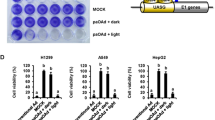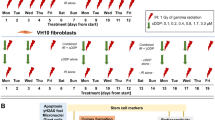Abstract
The radiation-inducible EGR-1-promoter has been used in different gene therapy approaches in order to enhance and locally restrict therapeutic efficacy. The aim of this study was to reduce nonspecific gene expression in the absence of irradiation (IR) in an adenoviral vector. Rat rhabdomyosarcoma R1H tumor cells were infected with adenoviral vectors expressing either EGFP or HSV-TK under control of the murine EGR-1 promoter/enhancer. Cells were irradiated at 0–6 Gy. Gene expression was determined by FACS-analysis (EGFP), or crystal violet staining (HSV-TK). The bovine growth hormone polyadenylation signal (BGH pA) was used as insulating sequence and was introduced upstream or upstream and downstream of the expression cassette. Infected R1H cells displayed IR dose-dependent EGFP expression. Cells treated with IR, AdEGR.TK and ganciclovir displayed a survival of 17.3% (6 Gy). However, significant gene expression was observed in the absence of IR with EGR.TK and EGR.EGFP constructs. Introduction of BGHpA upstream or upstream and downstream of expression cassette resulted in decreased nonspecific cytotoxicity by a factor of 1.6–2.3 with minor influence on the induced level of cytotoxicity. Introduction of insulating sequences in adenoviral vectors might allow tighter temporospatial control of gene expression by the radiation-inducible EGR-1 promoter.
This is a preview of subscription content, access via your institution
Access options
Subscribe to this journal
Receive 12 print issues and online access
$259.00 per year
only $21.58 per issue
Buy this article
- Purchase on Springer Link
- Instant access to full article PDF
Prices may be subject to local taxes which are calculated during checkout





Similar content being viewed by others
Abbreviations
- MOI:
-
multiplicity of infection
- CArG Box:
-
CC(A/T)6GG like sequence
- GCV:
-
ganciclovir
- IR:
-
irradiation
- Egr-1:
-
early growth response gene
- BGH:
-
bovine growth hormone
References
Gómez-Navarro J, Curiel DT, Douglas JT . Gene therapy for cancer. Eur J Cancer. 1999;35:867–885.
Hallahan DE, Mauceri HJ, Seung LP, et al. Spatial and temporal control of gene therapy using ionizing radiation. Nat Med. 1995;1:786–791.
Hallahan DE, Sukhatme VP, Virudachalam S, Kufe DW, Weichselbaum RR . Protein kinase C mediates X-ray inducibility of nuclear signal transducers, Egr-1, and c-jun. Proc Natl Acad Sci USA. 1991;88:2152–2160.
Datta R, Rubin E, Sukhatme VP, et al. Ionizing radiation activates transcription of the EGR1 gene via CArG elements. Proc Natl Acad Sci USA. 1992;89:10149–10153.
Datta R, Taneja N, Sukhatme VP, Qureshi SA, Weichselbaum R, Kufe DW . Reactive oxygen intermediates target CC(A/T)6GG sequences to mediate activation of the early growth response 1 transcription factor gene by ionizing radiation. Proc Natl Acad Sci USA. 1993;90:2419–2422.
Joki T, Nakamura M, Ohno T . Activation of the radiosensitive EGR-1 promoter induces expression of the herpes simplex virus thymidine kinase gene and sensitivity of human glioma cells to gancyclovir. Hum Gene Ther. 1995;6:1507–1513.
Kawashita Y, Ohtsuru A, Kaneda Y, et al. Regression of hepatocellular carcinoma in vitro and in vivo by radiosensitizing suicide gene therapy under the inducible and spatial control of radiation. Hum Gene Ther. 1999;10:1509–1519.
Manome Y, Kunieda T, Wen PY, Koga T, Kufe DW, Ohno T . Transgene expression in malignant glioma using a replication-defective adenoviral vector containing the EGR-1 promoter: activation by ionizing radiation or uptake by radioactive iododeoxyuridine. Hum Gene Ther. 1998;9:1409–1417.
Marples B, Scott SD, Hendry JH, Embleton MJ, Lashford LS, Margison GP . Development of synthetic promoters for radiation-mediated gene therapy. Gene Therapy. 2000;7:511–517.
Mauceri HJ, Hanna NN, Wayne JD, Hallahan DE, Hellman S, Weichselbaum RR . Tumor necrosis factor a (TNF-α) gene therapy targeted by ionizing radiation selectively damages tumor vasculature. Cancer Res. 1996;56:4311–4314.
Meyer RG, Kupper JH, Kandolf R, Rodemann HP . Early growth response-1 gene (Egr-1) promoter induction by ionizing radiation in U87 malignant glioma cells in vitro. Eur J Biochem. 2002;269:337–346.
Steinwaerder DS, Lieber A . Insulation from viral transcriptional regulatory elements improves inducible transgene expression from adenovirus vectors in vitro and in vivo. Gene Therapy. 2000;7:556–567.
Vassaux G, Hurst HC, Lemoine NR . Insulation of a conditionally expressed transgene in an adenoviral vector. Gene Therapy. 1999;6:1192–1197.
Barendsen GW, Broerse JJ . Experimental radiotherapy of a rat rhabdomyosarcoma with 15 MeV neutrons and 300 kV X-rays I: effects of single exposures. Eur J Cancer. 1969;5:373–391.
Reinhold HS . A cell dispersion technique for use in quantitative transplantation studies with solid tumours. Eur J Cancer. 1965;1:67–71.
Sambrook J, Fritsch EF, Maniatis T . Molecular cloning. In: Nolan C, ed. A Laboratory Manual, 2nd edn. New York: Cold Spring Harbor Laboratory Press; 1989.
Anton M, Graham FL . Site-specific recombination mediated by an adenovirus vector expressing the Cre recombinase protein: a molecular switch for control of gene expression. J Virol. 1995;69:4600–4606.
Tsai-Morris C-H, Cao X, Sukhatme VP . 5′flanking sequence and genomic structure of Egr-1, a murine mitogen inducible zinc finger encoding gene. Nucleic Acids Res. 1988;16:8835–8846.
Bett AJ, Haddara W, Prevec L, Graham FL . An efficient and flexible system for construction of adenovirus vectors with insertions or deletions in early regions 1 and 3. Proc Natl Acad Sci USA. 1994;91:8802–8806.
Hitt M, Bett AJ, Addison CL, et al. Techniques for human adenovirus vector construction and characterization. In: Adolph KW, ed. Viral Gene Techniques. San Diego, New York, Boston, London, Sydney, Tokyo, Toronto: Academic Press; 1995: pp 13–30.
Seung LP, Mauceri HJ, Beckett MA, Hallahan DE, Hellman S, Weichselbaum RR . Genetic radiotherapy overcomes tumor resistance to cytotoxic agents. Cancer Res. 1995;55:5561–5565.
Scott SD, Joiner MC, Marples B . Optimizing radiation-responsive gene promoters for radiogenetic cancer therapy. Gene Therapy. 2002;9:1396–1402.
Scott SD, Marples B, Hendry JH, et al. A radiation-controlled molecular switch for use in gene therapy of cancer. Gene Therapy. 2000;7:1121–1125.
Schmidt M, Heimberger T, Gruensfelder P, Schler G, Hoppe F . Inducible promoters for gene therapy of head and neck cancer: an in vitro study. Eur Arch Otorhinolaryngol. 2004;261:208–215.
Santiago FS, Lowe HC, Day FL, Chesterman CN, Khachigian LM . Early groth response factor-1 induction by injury is triggered by release and paracrine activation by fibroblast growth factor-2. Am J Pathol. 1999;154:937–944.
Buvoli M, Langer SJ, Bialik S, Leinwand LA . Potential limitations of transcription terminators used as transgene insulators in adenoviral vectors. Gene Therapy. 2002;9:227–231.
Pederson LC, Buchsbaum DJ, Vickers SM, et al. Molecular chemotherapy combined with radiation therapy enhances killing of cholangiocarcinoma cells in vitro and in vivo. Cancer Res. 1997;57:4325–4332.
Acknowledgements
The skillful technical assistance of S Wegerer and B Essien is greatly acknowledged. We thank P Wendt for FACS Analysis. Plasmid pE425 was kindly provided by VP Sukhatme. This work was supported by Deutsche Forschungsgemeinschaft (grant number WU 335/1-1). IEOG was supported by a DAAD PhD scholarship.
Author information
Authors and Affiliations
Corresponding author
Rights and permissions
About this article
Cite this article
Anton, M., Gomaa, I., von Lukowicz, T. et al. Optimization of radiation controlled gene expression by adenoviral vectors in vitro. Cancer Gene Ther 12, 640–646 (2005). https://doi.org/10.1038/sj.cgt.7700829
Received:
Published:
Issue Date:
DOI: https://doi.org/10.1038/sj.cgt.7700829
Keywords
This article is cited by
-
Co-overexpression of TRAIL and Smac sensitizes MDA-MB-231 cells to radiation through apoptosis depending on mitochondrial pathway
Radiation and Environmental Biophysics (2022)
-
Application of conditionally replicating adenoviruses in tumor early diagnosis technology, gene-radiation therapy and chemotherapy
Applied Microbiology and Biotechnology (2016)
-
Induced transgene expression for the treatment of solid tumors by hematopoietic stem cell-based gene therapy
Cancer Gene Therapy (2012)
-
Combined effects of radiotherapy and endostatin gene therapy in melanoma tumor model
Radiation and Environmental Biophysics (2008)



